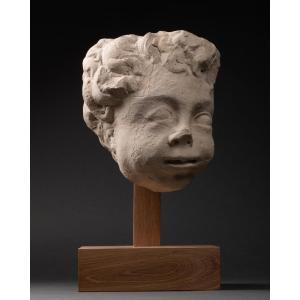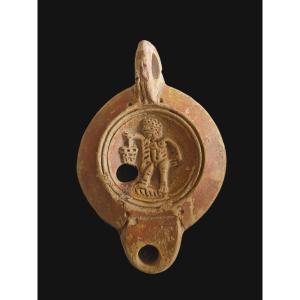Richly decorated, the stele comprises three distinct parts:
The first is the main composition, set in a temple décor. The triangular pediment is decorated with a frieze of palmettes. A four-petal flower marks its center. Underneath is a blank, uncarved frieze of metopes. Two columns in relief support the structure. They are composed of a rather schematic Corinthian capital, a carved pillar and an imposing base.
Between the two columns, and thus at the center of the architectural composition, is a female figure with raised arms. Her head is so uneven that we can't make out her facial features. She holds her veil firmly in her hands. She is wearing a long, short-sleeved dress, with a mantle draped over her shoulders. The collar of the dress is V-shaped and the folds of the drapery are rigid.
The second part of the stele lies below the composition. It is a three-line epitaph in Latin, set in a frame. It reads: DIS.MAN.SAC / AULA LVCAN. APIA / VIXIT.ANNIS.LV.HSE. The words “DIS. MAN(ibus) SAC(rum) / AULA LVCAN(us) APIA / VIXIT. ANNIS. LV. H(ic) S(epultum) E(st)", which translates as ‘Consecrated to the gods Manes / Aula Lucan(us) Apia / lived 55 years, is buried here’. The inscription then identifies the deceased.
The last part is a square, undecorated block, smaller than the rest of the stele, probably buried.
The stele belongs to the Greek type of naiskos, or aedicula in Rome.
Naiskoi can be simple stelae or large-scale architectural monuments. This type of funerary architecture developed around the 5th century B.C. in Greece and enjoyed great popularity during the Hellenistic period (323 B.C. - 31 B.C.). Outside Greece, this type of architecture can be found in Taranto, where it underwent significant development both in statuary and in ceramics as an iconographic motif, as well as in Roman Gaul, where small terracotta naïskos have been found. In Roman art, the naïskos is known as an aedicula.
This stele is not easy to date, but a few clues can be used to delineate chronological milestones: the presence of an invocation to the Manes gods, which appears on tombs at the beginning of the Empire (1st century BC); the presence of the adjective “sacrum” is an addition from the 2nd century AD. The stela must therefore date from around the 2nd century AD, as invocations to the Manes gods were gradually replaced in the 3rd and 4th centuries.
Stelae following a Roman tradition enjoyed great popularity in the Roman world. Found all over the empire, some of these steles, whether funerary or votive, bear a striking resemblance to the one shown here. Of particular interest is this Punic-Roman relief featuring a figure of Persephone, dated to the 2nd-3rd century AD and now in the Turin Archaeological Museum. The two architectural compositions are quite similar, unlike the decorations on the lion and the main figure, which differ.
















































 Le Magazine de PROANTIC
Le Magazine de PROANTIC TRÉSORS Magazine
TRÉSORS Magazine Rivista Artiquariato
Rivista Artiquariato